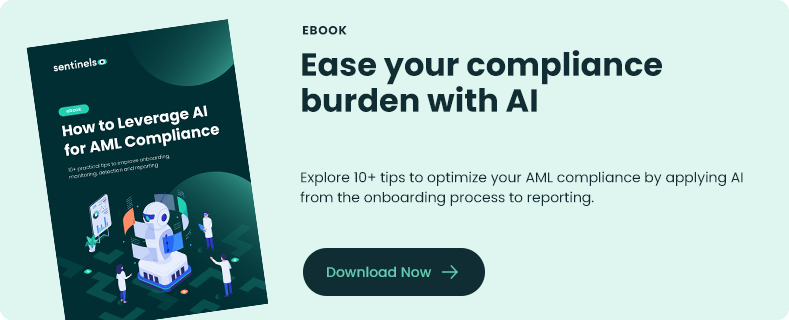Money laundering is a strange activity, it is constantly changing yet at its core it always stays the same. It’s the transfer of illicit money into seemingly legitimate money.
What is money laundering? A basic guide to AML
Money laundering is a strange activity, it is constantly changing yet at its core it always stays the same. It’s the transfer of illicit money into seemingly legitimate money.
Sentinels
Table of contents
It’s estimated that globally the anti-money laundering (AML) market is poised for rapid growth over the next eight years, with an anticipated value of $5.77 billion by 2030 up from $1.63 billion in 2021. Money laundering causes approximately $2 trillion in dirty money to flow through the global financial system each year.
One factor driving AML growth is the introduction of increasingly stringent AML regulations around the world. Particularly in Europe, which is piling pressure on firms to deploy better AML prevention, detection, and reporting processes in a bid to control the rapid growth of money laundering activity
How does money laundering work?
Money laundering is a process whereby criminals take illicit proceeds generated through activities such as drug trafficking and use a range of methods to turn it into seemingly legitimate funds or assets. The money from the criminal activity is considered dirty due to its illicit source, and the process of moving this money through the global financial system launders it to make it look clean.
What are the three stages of money laundering?
Money laundering generally takes place through three key stages.
1) Placement
Money laundering begins with placement. This occurs when illicit funds are placed within the financial system. One of the most common ways this is achieved is through scaling, whereby criminals take large amounts of money and divide it into smaller sums that are less likely to set off alarm bells and are harder to track.
This enables criminals to deposit their illicit funds directly into bank accounts or purchase other financial instruments such as cheques and money orders. By placing the illicit funds into accounts and other financial instruments, criminals attempt to quietly disguise and distance it from the crime it was acquired from.
Another popular placement strategy is offshoring, whereby criminals move money into overseas accounts while still retaining control over it.
Layering
Layering is the second stage of money laundering. The purpose of layering is to make the illicit funds difficult to detect by distancing it further from the illegal source.
During the layering stage, the illicit funds are usually blended with legitimate funds or are constantly moved from one account to the other. This generates lots of different transactions which are harder to track, essentially making the illicit funds “disappear”.
There are lots of different layering methods, including:
- Stock and foreign exchange market trading
- Buying foreign money orders
- Buying and selling luxury assets
- Gaming in casinos and exchanging the funds for chips
The whole point of layering is to place hurdles in between the illicit funds and its original source to make it more difficult for investigators to identify money laundering activity and distinguish it from legitimate funds.
3) Integration
The final stage of money laundering is integration. As the term suggests, this is where the illicit funds are integrated back into legitimate financial accounts.
Just like during the layering stage, integration involves a series of smaller transactions. For example, if the illicit funds were just to buy a piece of real estate, this asset can then be sold to create a trail of legitimately sourced funds. Other ways illicit funds can be integrated include:
- Payroll fraud
- Paying out loans to directors of a shell company
- Paying dividends to shareholders of criminal enterprises
What is anti-money laundering?
Anti-money laundering is the collection of laws, regulations, procedures, and other controls that are aimed at detecting and preventing instances whereby criminals disguise illicit funds as legitimate income.
Since money laundering was first criminalized in 1989 alongside the founding of the Financial Action Task Force, financial firms have been required to implement AML risk procedures in place to prevent money laundering and other key financial crimes.
As financial crime has become more sophisticated over time, AML regulations and the methods that firms use to detect it have had to constantly evolve and remain one step ahead. In recent years, however, money laundering and other financial crimes have become much harder to detect, which has forced regulators to implement new regulations and controls thick and fast.
How AML works
Today, AML efforts work through a series of processes and measures that most financial institutions are obligated by law to carry out.
Know Your Customer
AML begins when financial institutions verify the identity of their new customers and clients, a process called Know Your Customer (KYC).
In addition to establishing and verifying their identity, firms are also required to understand the nature of a new client’s activity and verify that any funds deposited have come from a legitimate source. Firms may also have to screen new clients against sanctions lists and law enforcement databases.
Customer Due Diligence
Customer Due Diligence (CDD) is the process through which firms ensure that information provided by new customers and clients is accurate and legitimate.
CDD requires constant assessment of the money laundering risks posed by each client. By adopting this risk-based approach, firms can identify clients that pose a higher risk of non-compliance so that they can be more closely monitored and scrutinized.
Transaction monitoring
Transaction monitoring is another core part of the AML process, and most firms are obligated to have a suitable monitoring process in place so that suspicious transactions can be identified, flagged, and reported to regulators.
It’s a largely automated process that uses sophisticated technologies and tools to instantly flag transactions that are out of the ordinary for individual clients, such as an unusually large cash deposit or a purchase being made in a blacklisted jurisdiction.
All transaction monitoring is heavily reliant on the business rules developed to discern potential criminal behavior and money laundering activity. The development aspect of rules can vary greatly.
At Sentinels we use a no-code editor to deploy business rules at speed and keep users in control. This means rules can be iterated at pace and thoroughly tested in our sand-box environment to scope out changes before they're implemented into a transaction monitoring program to detect money laundering activity.
One of the more important features of transaction monitoring is the presence of event driven reviews (EDRs). These allow a compliance analyst to trigger a review at any point during the investigation flow. When an unusual transaction is detected or there's a risk-profile change then a review can be requested alongside all pertinent information to the transaction.
Transaction monitoring has traditionally been considered a post-activity process, happening in bulk and analysing multiple transactions to determine patterns of behavior. That is post-event transaction monitoring. But thanks to technological advances, customer behavior can be analysed immediately, resulting in real-time transaction monitoring.
Post-event transaction monitoring
Post-event transaction monitoring reacts to events after they happen. It uncovers financial crime threats and focuses on reducing false positives while delivering actionable intelligence so businesses can respond appropriately.
Real-time transaction monitoring
Thanks to new machine learning technology it’s now possible to conduct real-time transaction monitoring. Management and maintenance of the business rules can be done in a no-code environment controlled by compliance teams or automated with unsupervised machine learning that learns criminal patterns over time.



